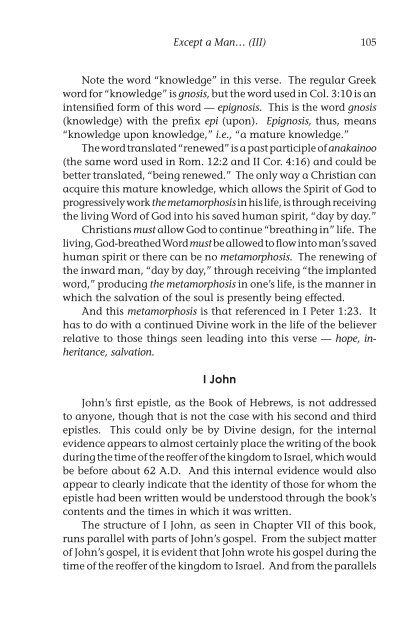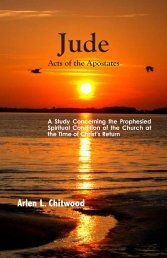Signs in John's Gospel - The Lamp Broadcast
Signs in John's Gospel - The Lamp Broadcast
Signs in John's Gospel - The Lamp Broadcast
You also want an ePaper? Increase the reach of your titles
YUMPU automatically turns print PDFs into web optimized ePapers that Google loves.
Except a Man… (III) 105<br />
Note the word “knowledge” <strong>in</strong> this verse. <strong>The</strong> regular Greek<br />
word for “knowledge” is gnosis, but the word used <strong>in</strong> Col. 3:10 is an<br />
<strong>in</strong>tensified form of this word — epignosis. This is the word gnosis<br />
(knowledge) with the prefix epi (upon). Epignosis, thus, means<br />
“knowledge upon knowledge,” i.e., “a mature knowledge.”<br />
<strong>The</strong> word translated “renewed” is a past participle of anaka<strong>in</strong>oo<br />
(the same word used <strong>in</strong> Rom. 12:2 and II Cor. 4:16) and could be<br />
better translated, “be<strong>in</strong>g renewed.” <strong>The</strong> only way a Christian can<br />
acquire this mature knowledge, which allows the Spirit of God to<br />
progressively work the metamorphosis <strong>in</strong> his life, is through receiv<strong>in</strong>g<br />
the liv<strong>in</strong>g Word of God <strong>in</strong>to his saved human spirit, “day by day.”<br />
Christians must allow God to cont<strong>in</strong>ue “breath<strong>in</strong>g <strong>in</strong>” life. <strong>The</strong><br />
liv<strong>in</strong>g, God-breathed Word must be allowed to flow <strong>in</strong>to man’s saved<br />
human spirit or there can be no metamorphosis. <strong>The</strong> renew<strong>in</strong>g of<br />
the <strong>in</strong>ward man, “day by day,” through receiv<strong>in</strong>g “the implanted<br />
word,” produc<strong>in</strong>g the metamorphosis <strong>in</strong> one’s life, is the manner <strong>in</strong><br />
which the salvation of the soul is presently be<strong>in</strong>g effected.<br />
And this metamorphosis is that referenced <strong>in</strong> I Peter 1:23. It<br />
has to do with a cont<strong>in</strong>ued Div<strong>in</strong>e work <strong>in</strong> the life of the believer<br />
relative to those th<strong>in</strong>gs seen lead<strong>in</strong>g <strong>in</strong>to this verse — hope, <strong>in</strong>heritance,<br />
salvation.<br />
I John<br />
John’s first epistle, as the Book of Hebrews, is not addressed<br />
to anyone, though that is not the case with his second and third<br />
epistles. This could only be by Div<strong>in</strong>e design, for the <strong>in</strong>ternal<br />
evidence appears to almost certa<strong>in</strong>ly place the writ<strong>in</strong>g of the book<br />
dur<strong>in</strong>g the time of the reoffer of the k<strong>in</strong>gdom to Israel, which would<br />
be before about 62 A.D. And this <strong>in</strong>ternal evidence would also<br />
appear to clearly <strong>in</strong>dicate that the identity of those for whom the<br />
epistle had been written would be understood through the book’s<br />
contents and the times <strong>in</strong> which it was written.<br />
<strong>The</strong> structure of I John, as seen <strong>in</strong> Chapter VII of this book,<br />
runs parallel with parts of John’s gospel. From the subject matter<br />
of John’s gospel, it is evident that John wrote his gospel dur<strong>in</strong>g the<br />
time of the reoffer of the k<strong>in</strong>gdom to Israel. And from the parallels



